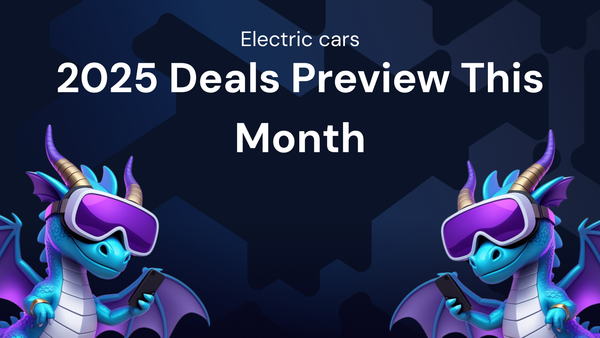Pricing Breakdown for electric cars with hidden deals

Pricing Breakdown for Electric Cars with Hidden Deals
The electric vehicle (EV) market is booming, offering a promising alternative to traditional gasoline-powered cars. However, navigating the world of EV pricing can feel like traversing a complex maze. While the sticker price might seem daunting, a closer look reveals a landscape of hidden deals, incentives, and long-term savings opportunities that can significantly reduce the overall cost of ownership. This article breaks down the pricing structure of electric cars, uncovering the hidden deals and strategies that can help you drive away with the best possible bargain. We're not recruiters, sellers, or service providers, but rather dedicated to providing you with accurate information and helpful tips to make informed decisions.
1. Understanding the Initial Sticker Price: More Than Meets the Eye
The first encounter most people have with an EV is the Manufacturer's Suggested Retail Price (MSRP), the sticker price plastered on the window. This figure represents the base cost of the vehicle before any additional features, upgrades, or government incentives are factored in. It's crucial to remember that the MSRP is just a starting point, and often negotiable, especially depending on market conditions, availability, and manufacturer promotions.
Key Considerations Regarding MSRP:
- Base Model vs. Trim Levels: The MSRP typically refers to the base model, often lacking desirable features. Higher trim levels with enhanced technology, safety features, and aesthetics will naturally come with a higher price tag.
- Optional Features and Packages: Manufacturers offer a wide array of optional features and packages that can significantly inflate the final price. Consider which features are essential for your needs and which are simply nice-to-haves.
- Destination and Delivery Charges: These fees cover the cost of transporting the vehicle from the factory to the dealership and are usually non-negotiable. They typically range from $1,000 to $2,000, depending on the manufacturer and distance.
- Market Demand and Availability: High-demand EVs may command prices above MSRP, particularly when supply is limited. Conversely, vehicles with lower demand may be available at a discount.
Tip: Use online car configurators on manufacturers' websites to build your ideal EV and get a realistic estimate of the MSRP with your desired features.
2. Federal Tax Credits: A Substantial Incentive
The U.S. federal government offers a significant incentive to encourage the adoption of electric vehicles: the Electric Vehicle Tax Credit. This credit can provide up to $7,500 in tax savings for eligible EV purchases. However, understanding the nuances of this credit is critical.
Key Aspects of the Federal Tax Credit:
- Eligibility: The credit applies to new, qualified plug-in electric vehicles (PEVs), including all-electric vehicles (BEVs) and plug-in hybrid electric vehicles (PHEVs).
- Credit Amount: The credit amount varies depending on the vehicle's battery capacity. Currently, the maximum credit is $7,500, but this may change as manufacturers reach certain production thresholds.
- Phase-Out: The credit begins to phase out for manufacturers after they sell 200,000 eligible vehicles. Tesla and General Motors have already reached this threshold, meaning their vehicles are no longer eligible for the full credit. Other manufacturers are approaching the phase-out point.
- Tax Liability: The credit is non-refundable, meaning you can only claim up to the amount of your tax liability. If your tax liability is less than $7,500, you won't receive the full credit.
- Used EVs: As of 2023, a federal tax credit of up to $4,000 is available for used EVs meeting specific requirements. This significantly expands the affordability of electric cars for a broader range of consumers. The used EV must be purchased from a licensed dealer for under $25,000.
Tip: Check the IRS website (irs.gov) or consult with a tax professional to determine your eligibility and the applicable credit amount for your chosen EV.
3. State and Local Incentives: Adding to the Savings
In addition to federal tax credits, many states, counties, and cities offer their own incentives for EV purchases. These incentives can include rebates, tax credits, reduced registration fees, and access to HOV lanes.
Types of State and Local Incentives:
- Rebates: These are direct cash payments offered by the state or local government after you purchase or lease an EV.
- Tax Credits: Similar to the federal tax credit, these reduce your state income tax liability.
- Reduced Registration Fees: Some states offer lower registration fees for EVs compared to gasoline-powered cars.
- HOV Lane Access: In some areas, EVs are allowed to use high-occupancy vehicle (HOV) lanes, even with a single occupant.
- Utility Company Incentives: Many utility companies offer rebates or discounted charging rates for EV owners.
- Charging Station Incentives: Some states or local governments offer incentives for installing home charging stations.
Finding State and Local Incentives:
- Database of State Incentives for Renewables & Efficiency (DSIRE): This website (dsireusa.org) provides a comprehensive database of state and local incentives for renewable energy and energy efficiency, including EVs.
- State Energy Offices: Visit the website of your state's energy office for information on available incentives.
- Local Utility Companies: Contact your local utility company to inquire about EV-related incentives and programs.
Tip: Research the incentives available in your area before purchasing an EV to maximize your savings.
4. Negotiating with Dealers: Mastering the Art of the Deal
While manufacturer incentives and government credits can lower the overall cost, negotiating with the dealer remains crucial. Dealers have some flexibility in pricing and can offer discounts, financing deals, and trade-in allowances.
Negotiation Strategies:
- Research Fair Market Value: Use online resources like Kelley Blue Book (kbb.com) and Edmunds (edmunds.com) to determine the fair market value of the EV you're interested in. This will give you a baseline for your negotiations.
- Shop Around: Get quotes from multiple dealerships to compare prices and leverage competing offers. Don't be afraid to walk away if you're not happy with the deal.
- Negotiate the Out-the-Door Price: Focus on the final out-the-door price, including all taxes, fees, and charges. This will give you a clear picture of the total cost.
- Trade-In Considerations: If you're trading in your old car, research its value beforehand and negotiate separately from the EV price. Dealers may try to lowball your trade-in to offset discounts on the EV.
- Be Prepared to Walk Away: The most powerful negotiation tool is the ability to walk away from a deal that doesn't meet your needs. Dealers are often more willing to offer a better price to avoid losing a sale.
- End-of-Month/Quarter/Year Deals: Dealerships are often under pressure to meet sales quotas at the end of the month, quarter, or year, making them more willing to offer discounts.
- Online vs. In-Person Negotiation: Consider negotiating online first to get a preliminary quote before visiting the dealership. This can save you time and effort.
Tip: Don't be afraid to negotiate aggressively and be prepared to walk away if the dealer isn't willing to offer a fair price.
5. Leasing vs. Buying: Weighing the Pros and Cons
Leasing and buying are two distinct financing options with different implications for the total cost of ownership.
Leasing:
- Lower Upfront Costs: Leasing typically requires a lower down payment and lower monthly payments compared to buying.
- Shorter Term: Leases usually last for 2-3 years, allowing you to upgrade to a newer model more frequently.
- Warranty Coverage: During the lease term, the vehicle is usually covered by the manufacturer's warranty, reducing maintenance costs.
- Mileage Restrictions: Leases often come with mileage restrictions, and exceeding those limits can result in extra charges.
- No Ownership: At the end of the lease term, you return the vehicle to the dealership and don't own it.
- Tax Credit Benefit: In some cases, the leasing company may pass the federal tax credit on to you in the form of lower monthly payments.
Buying:
- Ownership: You own the vehicle outright and can customize it as you please.
- No Mileage Restrictions: You can drive as many miles as you want without incurring extra charges.
- Long-Term Cost Savings: Over the long term, buying can be more cost-effective than leasing, especially if you plan to keep the vehicle for many years.
- Higher Upfront Costs: Buying typically requires a larger down payment and higher monthly payments compared to leasing.
- Depreciation: The value of the vehicle will depreciate over time, reducing its resale value.
- Maintenance Costs: After the warranty expires, you'll be responsible for all maintenance and repair costs.
Considerations for EVs:
- Rapid Technological Advancements: The EV market is evolving rapidly, with new models and technologies emerging frequently. Leasing allows you to stay up-to-date with the latest advancements.
- Battery Life: Battery technology is improving, but battery degradation can still be a concern over the long term. Leasing eliminates the risk of owning a vehicle with a degraded battery.
Tip: Carefully weigh the pros and cons of leasing and buying to determine which option best suits your needs and financial situation. Consider how long you plan to keep the vehicle and how much you drive.
6. Hidden Costs and Long-Term Savings: Beyond the Purchase Price
The initial purchase price of an EV is just one piece of the puzzle. To truly understand the cost of ownership, you need to consider the long-term savings and potential hidden costs.
Long-Term Savings:
- Fuel Savings: EVs are significantly cheaper to fuel than gasoline-powered cars. Electricity prices are generally lower than gasoline prices, and EVs are more energy-efficient.
- Reduced Maintenance: EVs have fewer moving parts than gasoline-powered cars, resulting in lower maintenance costs. They don't require oil changes, spark plug replacements, or exhaust system repairs.
- Tax Benefits: Depending on your location, you may be eligible for tax deductions or credits related to EV ownership.
- Resale Value: The resale value of EVs is generally holding up well, and some models are even appreciating in value due to high demand.
Potential Hidden Costs:
- Home Charging Station Installation: Installing a Level 2 home charging station can cost several hundred to several thousand dollars, depending on the complexity of the installation.
- Electricity Costs: While electricity is cheaper than gasoline, you'll still need to factor in the cost of charging your EV at home or at public charging stations.
- Battery Replacement: While EV batteries are designed to last for many years, they will eventually need to be replaced. Battery replacement costs can be significant, although they are decreasing over time.
- Tire Wear: EVs are often heavier than gasoline-powered cars, which can lead to increased tire wear.
- Insurance Costs: Insurance rates for EVs may be slightly higher than for comparable gasoline-powered cars.
Tip: Factor in the long-term savings and potential hidden costs to get a complete picture of the total cost of ownership for an EV. Use online calculators to estimate your fuel savings and maintenance costs.
7. Exploring Used EV Options: A Budget-Friendly Alternative
The used EV market is growing rapidly, offering a more affordable way to experience electric driving. Used EVs can be a great option for budget-conscious buyers, but it's essential to do your research and understand the potential risks.
Benefits of Buying a Used EV:
- Lower Price: Used EVs are significantly cheaper than new EVs.
- Depreciation: You avoid the initial depreciation hit that new car buyers experience.
- Federal Tax Credit: As mentioned earlier, used EVs meeting certain requirements are eligible for a federal tax credit of up to $4,000.
Considerations When Buying a Used EV:
- Battery Health: The battery is the most critical component of an EV, so it's crucial to assess its health. Ask for a battery health report, which can provide information on the battery's capacity and degradation.
- Warranty: Check the remaining warranty coverage on the battery and other components.
- Mileage: Lower mileage EVs typically have less battery degradation.
- Charging Infrastructure Compatibility: Ensure that the used EV is compatible with your local charging infrastructure.
- Vehicle History Report: Obtain a vehicle history report to check for accidents, damage, or title issues.
- Expert Inspection: Consider having a qualified mechanic inspect the used EV before you buy it.
Finding Used EVs:
- Online Marketplaces: Websites like Carvana, Vroom, and Craigslist offer a wide selection of used EVs.
- Dealerships: Many dealerships sell used EVs, including certified pre-owned (CPO) models.
- Private Sellers: You can also find used EVs for sale by private sellers.
Tip: Thoroughly inspect the battery health and vehicle history before buying a used EV. Consider having a qualified mechanic inspect the vehicle.
8. Public Charging Networks and Costs: Essential for EV Ownership
While home charging is the most convenient and cost-effective way to keep your EV powered, access to public charging networks is essential for longer trips and situations where home charging isn't available. Understanding the costs and availability of public charging is critical for EV ownership.
Public Charging Networks:
- Tesla Supercharger Network: Tesla operates its own network of Superchargers, which are exclusively for Tesla vehicles.
- ChargePoint: ChargePoint is one of the largest public charging networks in North America, with stations located in a variety of locations, including shopping centers, workplaces, and parking garages.
- Electrify America: Electrify America is a network of DC fast-charging stations that are compatible with a wide range of EV models.
- EVgo: EVgo is another network of DC fast-charging stations, with a focus on providing fast and reliable charging.
Charging Costs:
- Per-kWh Pricing: Most public charging networks charge by the kilowatt-hour (kWh) of electricity consumed.
- Per-Minute Pricing: Some charging stations charge by the minute, particularly DC fast-charging stations.
- Idle Fees: Some charging networks charge idle fees if you leave your vehicle plugged in after it's fully charged.
- Subscription Fees: Some charging networks offer subscription plans that provide discounted charging rates.
Finding Public Charging Stations:
- Charging Station Apps: Apps like PlugShare, ChargePoint, and Electrify America can help you locate public charging stations near you.
- In-Car Navigation Systems: Many EVs have built-in navigation systems that can locate charging stations and provide real-time availability information.
Tip: Research the public charging networks in your area and download the relevant apps. Familiarize yourself with the charging costs and idle fees.
9. Insurance Considerations for Electric Cars:
Electric cars, while offering numerous benefits, often come with unique insurance considerations. Understanding these factors can help you navigate the insurance landscape and secure the best possible rates.
- Higher Vehicle Value: EVs generally have a higher initial purchase price compared to their gasoline counterparts. This higher value translates to potentially higher premiums, as insurance companies need to cover a larger potential payout in case of an accident.
- Battery Coverage: One crucial aspect of EV insurance is battery coverage. Ensure that your policy covers battery damage or replacement due to accidents, fire, or other covered perils. Some policies may exclude or limit coverage for battery degradation over time.
- Specialized Repairs: EVs require specialized repair facilities and technicians, which can increase repair costs. Check if your insurance policy covers repairs at certified EV repair shops.
- Liability Coverage: Like any car, EVs require liability coverage to protect you financially if you're at fault in an accident that causes injuries or property damage to others.
- Available Discounts: Many insurance companies offer discounts for EVs, such as discounts for having advanced safety features, being an environmentally conscious driver, or bundling your auto and home insurance.
Tip: Shop around and compare insurance quotes from multiple companies. Inquire about specific EV coverage options and available discounts.
10. Staying Informed: Resources and Updates
The EV market is constantly evolving, with new models, technologies, and incentives emerging regularly. Staying informed about the latest developments is essential for making informed decisions.
Resources for Staying Informed:
- EV News Websites: Websites like Electrek, Inside EVs, and CleanTechnica provide comprehensive coverage of the EV market.
- Manufacturer Websites: Visit the websites of EV manufacturers for information on their latest models and technologies.
- Government Websites: The IRS (irs.gov) and the Department of Energy (energy.gov) provide information on federal tax credits and other EV-related programs.
- Consumer Reports: Consumer Reports provides reviews and ratings of EVs, as well as information on reliability and safety.
- EV Forums and Communities: Online forums and communities are a great place to connect with other EV owners and share information.
Tip: Subscribe to EV news websites, follow EV manufacturers on social media, and join online forums and communities to stay up-to-date on the latest developments.
Conclusion:
The pricing of electric cars can seem complicated, but by understanding the various factors involved, you can uncover hidden deals and make informed decisions. Remember to consider the initial sticker price, federal and state incentives, negotiation strategies, leasing vs. buying options, long-term savings, and potential hidden costs. Explore used EV options and research public charging networks. By staying informed and doing your due diligence, you can drive away with an EV that fits your needs and budget while contributing to a cleaner and more sustainable future. Happy driving!




